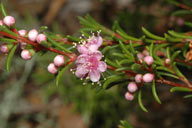In Flower This Week
A news sheet prepared by a Gardens' volunteer.
Numbers before each plant refer to temporary IFTW labels in the gardens.
Numbers in square brackets [ ] refer to garden bed Sections. Plants in flower are in bold type.
View past issues of 'In Flower This Week'.
4 March 2015
Hypocalymma jessicae click for larger image |
Start today’s walk from the Visitor Information Centre (VIC) and walk up the hill behind the café.
- Spyridium burragorang [Section 174] on the right-hand side of the path has tiny white flowers surrounded by brown bracts and distinctive whitish floral leaves. It is confined to the Lake Burragorang district of New South Wales and considered rare in the wild.
- Also on the right in a pot is Hypocalymma jessicae [Section 174], a dainty bush with plenty of small pink flowers and heath-like foliage. It is native to south-west Western Australia between Albany and Esperance.
- Veer left up the hill behind the café to see on your right a standard form of Grevillea bipinnatifida ‘Jingle Bells’ [Section 124]. It has deeply divided stiff, prickly foliage and many trusses of pink and orange flowers.
- Callistemon montanus [Section 104] is on the left with bright red brushes with gold tips. It is a haven for both birds and butterflies. It is native to northern New South Wales and southern Queensland.
- Leptospermum amboinense [Section 104] is also on the left showing masses of small white “tea-tree” flowers on weeping foliage. It occurs naturally in Queensland and also in south-east Asia.
- On your right is Chrysocephalum apiculatum [Section 17] with bright gold buttons on grey-green foliage. This daisy is a perennial herb which is distributed across Australia in a wide range of environments.
- On your left is Brachyscome graminea [Section 123], or Grass Daisy, a light green groundcover with white flower heads with gold centres. It is widespread in south-eastern Australia, including Tasmania.
- At the top of the Rock Garden on the right is Grevillea ‘Mason’s Hybrid’ [Section 15h], a spreading bush with large spider blooms of pink, red and orange. This hybrid arose as a seedling from seed collected from an upright glaucous form of Grevillea bipinnatifida. The other parent is presumed to be G. banksii.
- Also on the right is Grevillea lanigera [Section 15h], with grey-green foliage and pink and cream flowers on a low bush. This grevillea is very long flowering and useful in the garden. It is commonly known as Woolly Grevillea, and is endemic to Victoria and New South Wales.
- Xerochrysum bracteatum [Section 15h], or Paper Daisy, is on the right with a mass of bright gold papery flowerheads on green linear foliage. This bright patch is full of butterflies. This plant is widespread in various habitats in all Australian states and territories.
- On the right is Grevillea sericea subsp. sericea [Section 15k], an airy bush with light green foliage and white spider flowers. This plant occurs naturally west of Sydney.
- Turn right down the Main Path towards the waterfall. Callistemon comboynensis [Section 15r], or Cliff Bottlebrush, is on your right with bright red flowers. This plant is native to Queensland and New South Wales.
- Also on your right is a low groundcover Commelina cyanea [Section 15r] with bright blue flowers. This plant is commonly known as Scurvy Weed, and is native to moist forests and woodlands of eastern Australia, Lord Howe Island and Norfolk Island.
- On the left is Xerochrysum viscosum [Section 326], or Sticky Everlasting, a small yellow daisy with darker centres and tangled green foliage. It is native to south-eastern Australia.
- Also on the left in a pot is Xerochrysum bracteatum ‘Dargan Hill Monarch’ [Section 326], a magnificent pale yellow paper daisy with green foliage. It is a herbaceous form of Xerochrysum bracteatum, first found growing about one mile inland from Cunningham's Gap in southern Queensland in May 1961.
Rosalind Walcott
![Director of National Parks [logo]](../../../../images/dnp_90px.gif)







